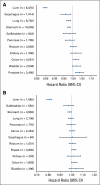Total cholesterol and cancer risk in a large prospective study in Korea
- PMID: 21422422
- PMCID: PMC3082977
- DOI: 10.1200/JCO.2010.31.5200
Total cholesterol and cancer risk in a large prospective study in Korea
Abstract
Purpose: To further clarify the relationship between total cholesterol and cancer, which remains unclear.
Methods: We prospectively examined the association between total cholesterol and site-specific and all-cancer incidence among 1,189,719 Korean adults enrolled in the National Health Insurance Corporation who underwent a standardized biennial medical examination in 1992 to 1995 and were observed for 14 years until cancer diagnosis or death.
Results: Over follow-up, 53,944 men and 24,475 women were diagnosed with a primary cancer. Compared with levels less than 160 mg/dL, high total cholesterol (≥ 240 mg/dL) was positively associated with prostate cancer (hazard ratio [HR], 1.24; 95% CI, 1.07 to 1.44; P trend = .001) and colon cancer (HR, 1.12; 95% CI, 1.00 to 1.25; P trend = .05) in men and breast cancer in women (HR, 1.17; 95% CI, 1.03 to 1.33; P trend = .03). Higher total cholesterol was associated with a lower incidence of liver cancer (men: HR, 0.42; 95% CI, 0.38 to 0.45; P trend < .001; women: HR, 0.32; 95% CI, 0.27 to 0.39; P trend < .001), stomach cancer (men: HR, 0.87; 95% CI, 0.82 to 0.93; P trend ≤ .001; women: HR, 0.86; 95% CI, 0.77 to 0.97; P trend = .06), and, in men, lung cancer (HR, 0.89; 95% CI, 0.82 to 0.96; P trend < .001). Results for liver cancer were slightly attenuated after additional adjustment for liver enzyme levels and hepatitis B surface antigen status (men: HR, 0.60; P trend < .001; women: HR, 0.46; P trend = .003) and exclusion of the first 10 years of follow-up (men: HR, 0.59; P trend < .001; women: HR, 0.44; P trend < .001). Total cholesterol was inversely associated with all-cancer incidence in both men (HR, 0.84; 95% CI, 0.81 to 0.86; P trend < .001) and women (HR, 0.91; 95% CI, 0.87 to 0.95; P trend < .001), but these associations were attenuated after excluding incident liver cancers (men: HR, 0.95; P trend < .001; women: HR, 0.98; P trend = .32).
Conclusion: In this large prospective study, we found that total cholesterol was associated with the risk of several different cancers, although these relationships differed markedly by cancer site.
Conflict of interest statement
Authors' disclosures of potential conflicts of interest and author contributions are found at the end of this article.
Figures

References
-
- Heart Protection Study Collaborative Group MRC/BHF Heart Protection Study of cholesterol lowering with simvastatin in 20,536 high-risk individuals: A randomized placebo-controlled trial. Lancet. 2002;360:7–22. - PubMed
-
- Huxley R, Lewington S, Clarke R. Cholesterol, coronary heart disease and stroke: A review of published evidence from observational studies and randomized controlled trials. Semin Vasc Med. 2002;2:315–323. - PubMed
-
- Toner CD, Davis CD, Milner JA. The vitamin D and cancer conundrum: Aiming at a moving target. J Am Diet Assoc. 2010;110:1492–1500. - PubMed
-
- Eliassen AH, Hankinson SE. Endogenous hormone levels and risk of breast, endometrial and ovarian cancers: Prospective studies. Adv Exp Med Biol. 2008;630:148–165. - PubMed
-
- Crawford ED. Understanding the epidemiology, natural history, and key pathways involved in prostate cancer. Urology. 2009;73(suppl 5):S4–S10. - PubMed
Publication types
MeSH terms
Substances
Grants and funding
LinkOut - more resources
Full Text Sources
Medical

